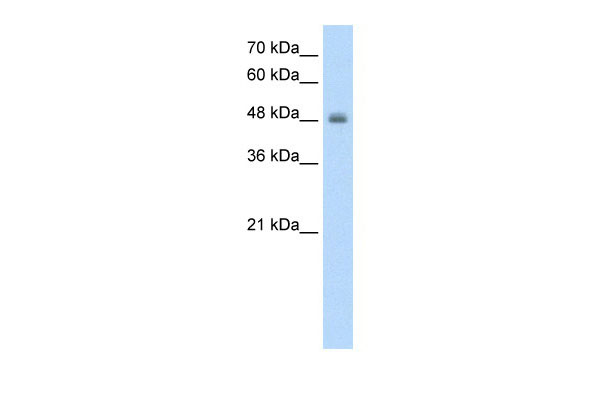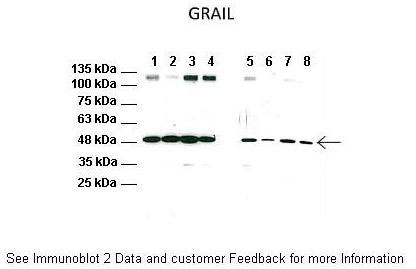RNF128 antibody - C-terminal region
Rabbit Polyclonal Antibody
- SPECIFICATION
- CITATIONS
- PROTOCOLS
- BACKGROUND

Application
| WB |
|---|---|
| Primary Accession | Q8TEB7 |
| Other Accession | NM_194463, NP_919445 |
| Reactivity | Human, Mouse, Rat, Rabbit, Pig, Horse, Bovine, Guinea Pig, Dog |
| Predicted | Human, Mouse, Rat, Dog |
| Host | Rabbit |
| Clonality | Polyclonal |
| Calculated MW | 47kDa |
| Gene ID | 79589 |
|---|---|
| Alias Symbol | FLJ23516, GRAIL |
| Other Names | E3 ubiquitin-protein ligase RNF128, 6.3.2.-, Gene related to anergy in lymphocytes protein, GRAIL, RING finger protein 128, RNF128 |
| Format | Liquid. Purified antibody supplied in 1x PBS buffer with 0.09% (w/v) sodium azide and 2% sucrose. |
| Reconstitution & Storage | Add 100 ul of distilled water. Final anti-RNF128 antibody concentration is 1 mg/ml in PBS buffer with 2% sucrose. For longer periods of storage, store at 20°C. Avoid repeat freeze-thaw cycles. |
| Precautions | RNF128 antibody - C-terminal region is for research use only and not for use in diagnostic or therapeutic procedures. |
| Name | RNF128 |
|---|---|
| Function | E3 ubiquitin-protein ligase that catalyzes 'Lys-27', 'Lys- 48'- or 'Lys-63'-linked polyubiquitin chains formation and plays a role in different biological processes such as modulation of immune response, cytoskeletal dynamics or protein homeostasis. Inhibits IL2 and IL4 transcription, thereby playing an important role in the induction of the anergic phenotype, a long-term stable state of T- lymphocyte unresponsiveness to antigenic stimulation associated with the blockade of interleukin production (PubMed:12705856). Ubiquitinates ARPC5 with 'Lys-48' linkages and COR1A with 'Lys-63' linkages leading to their degradation, down-regulation of these cytoskeletal components results in impaired lamellipodium formation and reduced accumulation of F-actin at the immunological synapse (PubMed:22016387). Functions in the patterning of the dorsal ectoderm; sensitizes ectoderm to respond to neural-inducing signals. Plays a positive role in innate immune response by promoting 'Lys-63'-linked ubiquitination of TBK1 after RNA- or DNA-virus infection (PubMed:27776110). Regulates alveolar macrophage activation and neutrophil infiltration by interacting with TLR4, targeting it for degradation, and inhibiting NF-kappa-B activation, hence decreasing pro-inflammatory cytokines (PubMed:37344492). Negatively regulates the IL-3/STAT5 signaling pathway by facilitating 'Lys-27'-linked polyubiquitination of IL3RA leading to its degradation via lysosomal pathway (PubMed:38702781). Directly regulates the N-glycosylation process in the endoplasmic reticulum by targeting the glycosyl-transferase RPN1 for ubiquitination and degradation (PubMed:39567208). Other substrates targeted for degradation by RNF128 include transmembrane proteins CD40L, CD83 or the tetraspanin CD151 (PubMed:18713730, PubMed:19542455). |
| Cellular Location | Cytoplasm. Endomembrane system; Single-pass membrane protein Cytoplasm, cytoskeleton. Cytoplasm, perinuclear region. Note=Localized in an asymmetric perinuclear punctate manner. Localizes to the internal pool of the transferrin recycling endosomal pathway. Partially colocalized with the endoplasmic reticulum resident HSPA5, with Golgi resident STX5, and with the late endosomal GTPase RAB7A (By similarity). |

Thousands of laboratories across the world have published research that depended on the performance of antibodies from Abcepta to advance their research. Check out links to articles that cite our products in major peer-reviewed journals, organized by research category.
info@abcepta.com, and receive a free "I Love Antibodies" mug.
Provided below are standard protocols that you may find useful for product applications.
If you have used an Abcepta product and would like to share how it has performed, please click on the "Submit Review" button and provide the requested information. Our staff will examine and post your review and contact you if needed.
If you have any additional inquiries please email technical services at tech@abcepta.com.













 Foundational characteristics of cancer include proliferation, angiogenesis, migration, evasion of apoptosis, and cellular immortality. Find key markers for these cellular processes and antibodies to detect them.
Foundational characteristics of cancer include proliferation, angiogenesis, migration, evasion of apoptosis, and cellular immortality. Find key markers for these cellular processes and antibodies to detect them. The SUMOplot™ Analysis Program predicts and scores sumoylation sites in your protein. SUMOylation is a post-translational modification involved in various cellular processes, such as nuclear-cytosolic transport, transcriptional regulation, apoptosis, protein stability, response to stress, and progression through the cell cycle.
The SUMOplot™ Analysis Program predicts and scores sumoylation sites in your protein. SUMOylation is a post-translational modification involved in various cellular processes, such as nuclear-cytosolic transport, transcriptional regulation, apoptosis, protein stability, response to stress, and progression through the cell cycle. The Autophagy Receptor Motif Plotter predicts and scores autophagy receptor binding sites in your protein. Identifying proteins connected to this pathway is critical to understanding the role of autophagy in physiological as well as pathological processes such as development, differentiation, neurodegenerative diseases, stress, infection, and cancer.
The Autophagy Receptor Motif Plotter predicts and scores autophagy receptor binding sites in your protein. Identifying proteins connected to this pathway is critical to understanding the role of autophagy in physiological as well as pathological processes such as development, differentiation, neurodegenerative diseases, stress, infection, and cancer.



